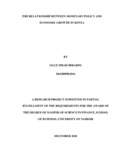| dc.contributor.author | Ogle, Ifra i | |
| dc.date.accessioned | 2019-02-01T11:44:12Z | |
| dc.date.available | 2019-02-01T11:44:12Z | |
| dc.date.issued | 2018 | |
| dc.identifier.uri | http://hdl.handle.net/11295/106295 | |
| dc.description.abstract | Monetary policies are some of the main drivers of the economic growth as it directly
impacts on the key economic variables. Economic growth on the other hand plays a key
role in improving citizens’ standards of living by influencing key economic factors.
Monetary policies have attracted a lot of interest in past from various scholars as they are
significant subject under macroeconomic theory. The objective of the study was to
determine the relationship between monetary policy and economic growth in Kenya. The
neoclassical growth theory, the quantity theory of money, the liquidity preference theory
and the new classical monetary tool formed the theoretical foundation of the study. The
study employed a descriptive research design and used quarterly secondary data covered
a 10-year period (2008-2017). The study used descriptive statistics to summarize the
collected data into meaningful form. Further, the study employed correlation to establish
the strength of association among the study variables and the multiple regression model
to establish the association among the study variables. The result revealed a positive and
not statistically significant relationship between the central bank rate and economic
growth (GDP) and that the relationship between open market operations (OMO) and real
GDP in Kenya was negative and significant. The findings also found that relationship
between cash reserve ratio and real GDP was positive and significant while the
relationship between exchange rate and real GDP was positive and statistically
significant. Finally, the study found that the relationship between interest rates and real
GDP was positive and not statistically significant. The study concluded that the open
market operations, cash reserve ratio and exchange rates significantly influence economic
growth in Kenya while the central bank rate and interest rates does not have a significant
influence on economic growth in Kenya. The study recommended that the Central Bank
of Kenya and the ministry of finance should use the open market operation mechanism to
raise finance since the use of open market operation tools enhances economic growth and
should set appropriate ratio of cash reserves requirement, which will in turn translate to
economic growth in Kenya. | en_US |
| dc.language.iso | en | en_US |
| dc.publisher | University of Nairobi | en_US |
| dc.rights | Attribution-NonCommercial-NoDerivs 3.0 United States | * |
| dc.rights.uri | http://creativecommons.org/licenses/by-nc-nd/3.0/us/ | * |
| dc.subject | The Relationship Between Monetary Policy and Economic Growth in Kenya | en_US |
| dc.title | The Relationship Between Monetary Policy and Economic Growth in Kenya | en_US |
| dc.type | Thesis | en_US |



